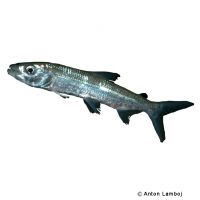Giant Tigerfish (Hydrocynus goliath)
| Giant Tigerfish Hydrocynus goliath | |
|---|---|
| Name | Giant Tigerfish |
| Name Lat. | Hydrocynus goliath |
| Family | African Tetras |
| Family lat. | Alestidae |
| Order | Characins |
| Order lat. | Characiformes |
| Origin | Africa |
| Habitat | Rivers, lakes |
| Diet | Carnivore |
| pH | 6.5-7.5 |
| Behavior | Predatory |
| Keeping | Individual, pair |
| Care Level | Experts only |
| Reproduction | Oviparous |
| Breeding | None reported |
| Life Span | 10-15 years |
| Protection | No |
| Metric Units | |
| Size | 130 cm |
| Temperature | 24-28 °C |
| Hardness | 10-25 °dH |
| Aquarium | 5,000 l |
| US Units | |
| Size | 51" |
| Temperature | 75-82 °F |
| Hardness | 178-445 ppm |
| Aquarium | 1,300 gal |
Distribution and habitat
Wolf tetras are widely distributed in the major rivers and lakes of the Congo River system, the Lualaba River, and Lakes Upemba and Tanganyika.
Maintenance
The well-structured large tank should have a robust border planting and offer hiding places from large roots and stones. They are very active swimmers and need plenty of swimming space. A substrate of fine gravel or sand, some subdued light (floating plants) and a weak current is ideal.
No ammonia, ammonium and nitrite should be detectable, the nitrate value should not exceed 100 mg/l. To ensure the water quality and oxygen content, a filter and heater adapted to the aquarium size is required, as well as lighting for the species-appropriate day-night rhythm of the animals.
Diet
In nature, this predatory fish feeds on fish. The food supply consists of live fish and large pieces of fish, which are well accepted even in frozen form.
A regular and varied diet promotes health and increases resistance. Feed only as much as is eaten immediately (in a maximum of 10 minutes).
Behaviour and compatibility
Juveniles can be kept with other defensible fish. Later they can only be kept with equal sized partners in the species tank. Any smaller fish, but also any fish of the same size is considered food.
Basically, only mutually compatible fish species with similar demands on water condition and water temperature may be socialized.
Sex dimorphism
There are no known external distinguishing characteristics.
Reproduction and breeding
There are no known reports of successful breeding in the aquarium.
Important
The wolf tetra is a dangerous, difficult-to-maintain predator, but an attractive display animal because of its conspicuous dentition.
The well-being of the fish should be checked regularly. Temperature should be checked daily, pH, hardness and nitrate levels should be checked at least every 14 days. Regular partial water changes are recommended, even if the contaminant level has not yet reached the upper limit. Sudden changes in water quality should be avoided. Newly introduced fish must be accustomed slowly to the water in the aquarium.
Further literature can be found in your pet store.
References
Text: petdata; Image: Anton Lamboj
Source: BMELV (1998): Tierschutzgutachten - Haltung von Zierfischen (Süßwasser); BAENSCH & RIEHL (2004): Aquarien Atlas Bd. 2, Mergus Verlag; ENGELMANN (2005): Zootierhaltung - Tiere in menschlicher Obhut: Fische, Zootierhaltung, Verlag Harri Deutsch
- Gemäß § 21 Abs. 5 Tierschutzgesetz idgF
